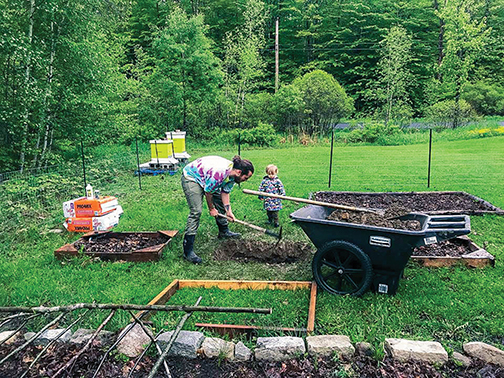 The most public and admired American homesteaders were Helen and Scott Nearing, authors of “Living the Good Life,” who left the bustle of New York City in the early decades of the 1900s for rural Vermont. They ended up in Harborside, Maine, where they lived sustainably for decades. It agreed with them. Scott lived until age 100, Helen until 91.
The most public and admired American homesteaders were Helen and Scott Nearing, authors of “Living the Good Life,” who left the bustle of New York City in the early decades of the 1900s for rural Vermont. They ended up in Harborside, Maine, where they lived sustainably for decades. It agreed with them. Scott lived until age 100, Helen until 91.
What exactly is homesteading? Brittney Fairfield of the Fairfield Family Homestead in Rome, Maine described it this way: “Homesteading…is more of a process than a result. It is [asking] a persistent question: How can I become more self-reliant?” From simple steps like drying clothes on a clothesline instead of in an electric dryer to bigger ones like installing solar panels to power your house, homesteading allows people to save money, have more control over their lives, help the community and even the planet.
Start a garden to grow your own vegetables, learn to put food “by” so you have it in winter, keep chickens for fresh eggs, get some bee hives for honey, but even more, to help pollinate crops. Those and many more fun, very do-able projects define homesteading. The entire family can get involved.
“My daughter is eight and she helps in the garden,” said Brittney Fairfield, and my three-year-old son loves to do everything. He’d put on a bee suit and get right into the hives if I let him.”
A native Mainer, Fairfield lives in the house where she grew up and gardens, keeps chickens and bees on its one-acre spread. Both she and her husband Ryan have their bachelor’s degrees from the University of Maine. Ryan Fairfield works at Johnny’s Selected Seeds and forages for mushrooms and other foods found in the wild, cooks and shoulders tasks at home in off-work hours.
Brittney Fairfield explains how they began creating their own homestead.
“It has been a gradual process for us that started when we decided to get chickens. After enjoying having our own eggs, we began small-scale gardening: cucumbers, tomatoes, pole beans and zucchini. Since then, we have turned most of our lawn into garden plots and have added garlic, potatoes, onions and asparagus. I also plant a variety of herbs and flowers for my honey bees and other pollinators – hyssop, lavender, basil, chives, catnip, bee balm and mint.”

A garden bounty after picking. Photo by Brittany Fairfield
From gardening, the Fairfields eventually got into keeping bees, joining the Kennebec Beekeepers Association, which meets at the Viles Arboretum in Augusta twice a month.
“If you are thinking of getting into bee-keeping, I highly recommend joining a club. You learn everything you need to know, get mentored and can even buy a starter kit from a member.”
Not only do bees provide honey for home use or gifting, they pollinate crops.
“Before we got the bees, we had lemon cucumbers, round and yellow, hence the name. After the bees went to work, our crop of those cucumbers tripled at least,” she said.
What is the initial investment for getting into the bee aspect of homesteading?
“I got my setup from another member of the Kennebec Beekeepers Association for $165. But there are places in Maine where you can go, depending on where you are. Swan’s Honey in Albion, Spicer Bees in Whitefield and Humble Abodes in Windsor can get people started.” And, she adds, “read, read, read.”
Homesteading is guided by the seasons and in winter, the bees need tending. They have to be wintered over, which means keeping them warm in the frigid weather.
“The biggest killer is moisture, but there is a type of board you put over the hive to absorb that. “Winter time for beekeepers is equal parts boring and stressful,” said Fairfield, “I wait and hope I’ve done everything I could to ensure their survival through the brutal winter.”
The reward comes in June and again in the fall, when she harvests the honey, making certain she leaves enough for the bees as a food source through winter and early spring, until they can find another food source.
At some point you get to cook all that food that’s produced or found. That falls to Ryan Fairfield, who also forages the countryside for mushrooms.

After foraging for mushrooms, Ryan Fairfield dries them for later use. Photo courtesy of Brittany Fairfield
“My favorite recipes use ingredients foraged from the forest. It’s not only an adventure to find the ingredients, but it’s an adventure to eat them. It’s exciting to use items you can’t find in a grocery store.”
Among his trove of recipes are Black Trumpet mushroom pizza, beer-battered Dryad’s Saddle mushrooms, Cattail pollen pancakes, and Bears Head Tooth mushroom “crab” cakes.
“We like to pickle everything from cucumbers to beans to beets, garlic scapes and eggs,” he said. “If it can be pickled, we’re going to try it. Last year I pickled Day Lily buds and fiddlehead ferns, which were both delicious.”
Both Ryan and Brittney Fairfield encourage people interested in following in their footsteps to read everything they can about the various aspects of homesteading. Eventually, they would like to spread the word.
“I would love to teach classes,” Brittney Fairfield said.”
And that is helping the community, an important part of the homesteading process.
She invited those interested to email her for more information about getting started at Brittney.fairfield@gmail.com.
Send questions/comments to the editors.



Comments are no longer available on this story